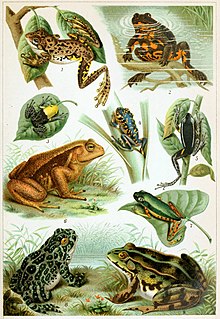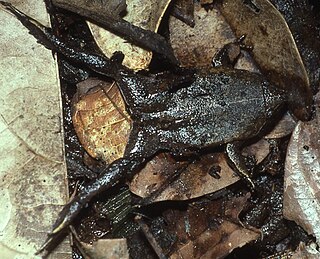
Ctenophryne is a genus of microhylid frogs. They occur in southern Central America and South America. Their common names are egg frogs and Nelson frogs, the latter applying to species in the formerly recognized Nelsonophryne.

Sachatamia ilex is a species of frog in the family Centrolenidae. It is found in eastern Nicaragua, Costa Rica, Panama, western Colombia, and western Ecuador. Common name Limon giant glass frog has been coined for this species, apparently in reference to its type locality in the canton of Limón, Costa Rica.

Cochranella euknemos, sometimes known as the San Jose Cochran frog, is a species of frog in the family Centrolenidae. It is found in central Costa Rica and south/eastward to Panama and to the western flank of the Cordillera Occidental in Colombia.
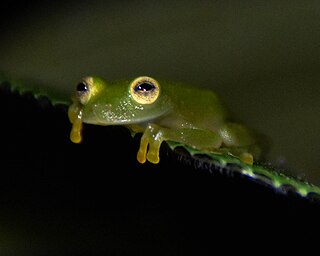
Hyalinobatrachium chirripoi is a species of frog in the family Centrolenidae. It is found in extreme northern Ecuador, northwestern Colombia, Panama, and Costa Rica, as well as in Honduras. The specific name chirripoi refers to the Chirripó Indians inhabiting the area of the type locality, Suretka in the Talamanca canton of Costa Rica. Common name Suretka glass frog has been coined for it.
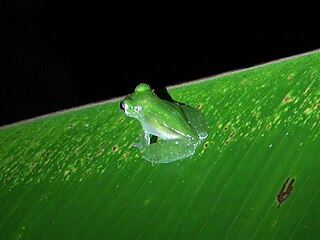
Hyalinobatrachium valerioi, sometimes known as the La Palma glass frog, is a species of frog in the family Centrolenidae. It is found in central Costa Rica and south to Panama and the Pacific lowlands and slopes of western Colombia and Ecuador; also in the Magdalena River Valley of Colombia.
Silverstoneia nubicola is a species of frog in the family Dendrobatidae. It is found in western Colombia, Panama, and southwestern Costa Rica.

Allobates talamancae is a species of frog in the Aromobatidae family. It is found in northwestern Ecuador, western Colombia, Panama, Costa Rica, and southern Nicaragua.

The gliding tree frog is a species of frog in family Hylidae. It is found in Colombia, Costa Rica, Ecuador, and Panama. Other common names are the gliding leaf frog and Spurrell's leaf frog. Its natural habitats are subtropical or tropical moist lowland forests and intermittent freshwater marshes. It is threatened by habitat loss.

Dendropsophus phlebodes, the San Carlos tree frog, is a species of frog in the family Hylidae. It is found in western Colombia, Costa Rica, Nicaragua and Panama. Its natural habitats are tropical moist lowland forests, but it may also occur in disturbed habitats. It is threatened by habitat loss.

The Canal Zone tree frog is a species of frog in the family Hylidae found in the Caribbean lowlands of eastern Nicaragua, Costa Rica, and central Panama, as well as the Pacific lowlands of Colombia, although the latter records are uncertain and may refer to Hypsiboas rosenbergi.

The Panama cross-banded tree frog is a species of frog in the family Hylidae found in the humid Pacific lowlands of southwestern Costa Rica to eastern Panama and in the Caribbean lowlands of Panama and northern Colombia.
Strabomantis anatipes is a species of frog in the Craugastoridae family. It is found in the Mira River drainage in extreme northern Ecuador and in adjacent southern Colombia in foothills and lower cloud forest on the Pacific lowlands and slopes of the Cordillera Occidental. It altitudinal range is 100–1,600 m (330–5,250 ft) asl.
Strabomantis anomalus is a species of frogs in the family Craugastoridae. It is found in the Chocoan rainforests from near sea level to elevations of 1,180 m (3,870 ft) in northwestern Ecuador and western Colombia.

Strabomantis bufoniformis is a species of frog in the family Craugastoridae. It is found in western Colombia, Panama, and southeastern Costa Rica. It is sometimes known as the rusty robber frog.

Craugastor fitzingeri is a species of frog in the family Craugastoridae. It is found in northwestern Colombia, Panama, Costa Rica, eastern Nicaragua, and northeastern Honduras. The specific name fitzingeri honors Leopold Fitzinger, an Austrian zoologist. Common name Fitzinger's robber frog has been coined for this species.
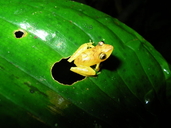
Pristimantis caryophyllaceus is a species of frog in the family Craugastoridae. It is found in Costa Rica and Panama; records from Colombia prior to 2010 refer to Pristimantis educatoris. However, taxonomy of Pristimantis caryophyllaceus and P. educatoris remain unsettled, and many sources continue to report Pristimantis caryophyllaceus from Colombia.
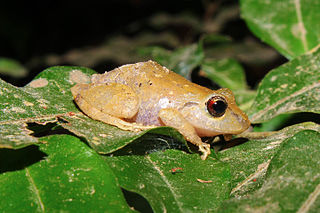
Pristimantis ridens, also known as the pygmy rain frog and the Rio San Juan robber frog, is a species of frog in the family Craugastoridae. It is found in western Colombia, and then through Panama and Costa Rica to Nicaragua and eastern Honduras.
Ctenophryne carpish is a rare and little-known species of microhylid frogs endemic to Peru. It is known from its type locality on the Cordillera de Carpish, Huánuco, and from near Juanjuí in the San Martín Region. It lacks eardrums, and at a cursory glance it resembles leptodactylid frogs of the genus Phrynopus, in which it was initially placed.
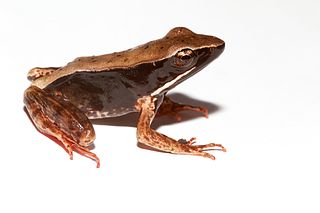
Warszewitsch's frog is a species of frog in the family Ranidae found in Honduras, Nicaragua, Costa Rica, and Panama.
Ctenophryne barbatula is a species of frog in the family Microhylidae. It is endemic to Peru and only known from the Yanachaga–Chemillén National Park, its type locality in the Pasco Region. The specific name barbatula is the diminutive of the Latin barbatus, meaning "bearded". It refers to the beard-like spines under the lower jaw of males.
